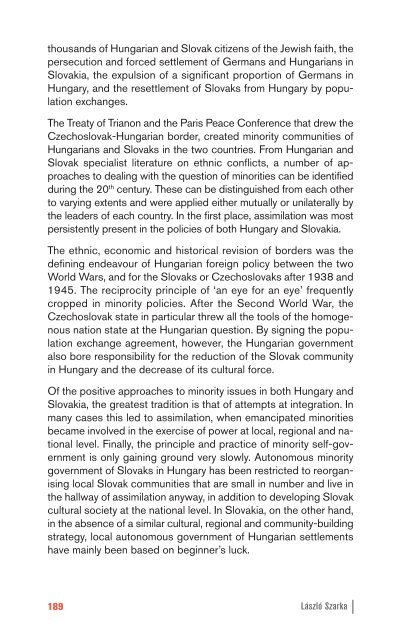Politics of the past: the use and abuse of history - Socialists ...
Politics of the past: the use and abuse of history - Socialists ...
Politics of the past: the use and abuse of history - Socialists ...
You also want an ePaper? Increase the reach of your titles
YUMPU automatically turns print PDFs into web optimized ePapers that Google loves.
thous<strong>and</strong>s <strong>of</strong> Hungarian <strong>and</strong> Slovak citizens <strong>of</strong> <strong>the</strong> Jewish faith, <strong>the</strong><br />
persecution <strong>and</strong> forced settlement <strong>of</strong> Germans <strong>and</strong> Hungarians in<br />
Slovakia, <strong>the</strong> expulsion <strong>of</strong> a significant proportion <strong>of</strong> Germans in<br />
Hungary, <strong>and</strong> <strong>the</strong> resettlement <strong>of</strong> Slovaks from Hungary by population<br />
exchanges.<br />
The Treaty <strong>of</strong> Trianon <strong>and</strong> <strong>the</strong> Paris Peace Conference that drew <strong>the</strong><br />
Czechoslovak-Hungarian border, created minority communities <strong>of</strong><br />
Hungarians <strong>and</strong> Slovaks in <strong>the</strong> two countries. From Hungarian <strong>and</strong><br />
Slovak specialist literature on ethnic conflicts, a number <strong>of</strong> approaches<br />
to dealing with <strong>the</strong> question <strong>of</strong> minorities can be identified<br />
during <strong>the</strong> 20 th century. These can be distinguished from each o<strong>the</strong>r<br />
to varying extents <strong>and</strong> were applied ei<strong>the</strong>r mutually or unilaterally by<br />
<strong>the</strong> leaders <strong>of</strong> each country. In <strong>the</strong> first place, assimilation was most<br />
persistently present in <strong>the</strong> policies <strong>of</strong> both Hungary <strong>and</strong> Slovakia.<br />
The ethnic, economic <strong>and</strong> historical revision <strong>of</strong> borders was <strong>the</strong><br />
defining endeavour <strong>of</strong> Hungarian foreign policy between <strong>the</strong> two<br />
World Wars, <strong>and</strong> for <strong>the</strong> Slovaks or Czechoslovaks after 1938 <strong>and</strong><br />
1945. The reciprocity principle <strong>of</strong> ‘an eye for an eye’ frequently<br />
cropped in minority policies. After <strong>the</strong> Second World War, <strong>the</strong><br />
Czechoslovak state in particular threw all <strong>the</strong> tools <strong>of</strong> <strong>the</strong> homogenous<br />
nation state at <strong>the</strong> Hungarian question. By signing <strong>the</strong> population<br />
exchange agreement, however, <strong>the</strong> Hungarian government<br />
also bore responsibility for <strong>the</strong> reduction <strong>of</strong> <strong>the</strong> Slovak community<br />
in Hungary <strong>and</strong> <strong>the</strong> decrease <strong>of</strong> its cultural force.<br />
Of <strong>the</strong> positive approaches to minority issues in both Hungary <strong>and</strong><br />
Slovakia, <strong>the</strong> greatest tradition is that <strong>of</strong> attempts at integration. In<br />
many cases this led to assimilation, when emancipated minorities<br />
became involved in <strong>the</strong> exercise <strong>of</strong> power at local, regional <strong>and</strong> national<br />
level. Finally, <strong>the</strong> principle <strong>and</strong> practice <strong>of</strong> minority self-government<br />
is only gaining ground very slowly. Autonomous minority<br />
government <strong>of</strong> Slovaks in Hungary has been restricted to reorganising<br />
local Slovak communities that are small in number <strong>and</strong> live in<br />
<strong>the</strong> hallway <strong>of</strong> assimilation anyway, in addition to developing Slovak<br />
cultural society at <strong>the</strong> national level. In Slovakia, on <strong>the</strong> o<strong>the</strong>r h<strong>and</strong>,<br />
in <strong>the</strong> absence <strong>of</strong> a similar cultural, regional <strong>and</strong> community- building<br />
strategy, local autonomous government <strong>of</strong> Hungarian settlements<br />
have mainly been based on beginner’s luck.<br />
189 László Szarka





